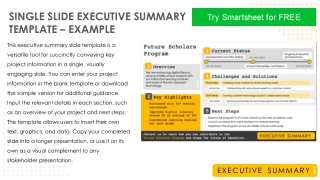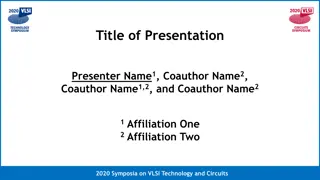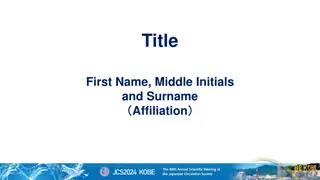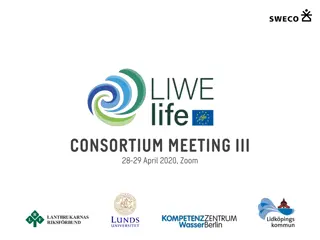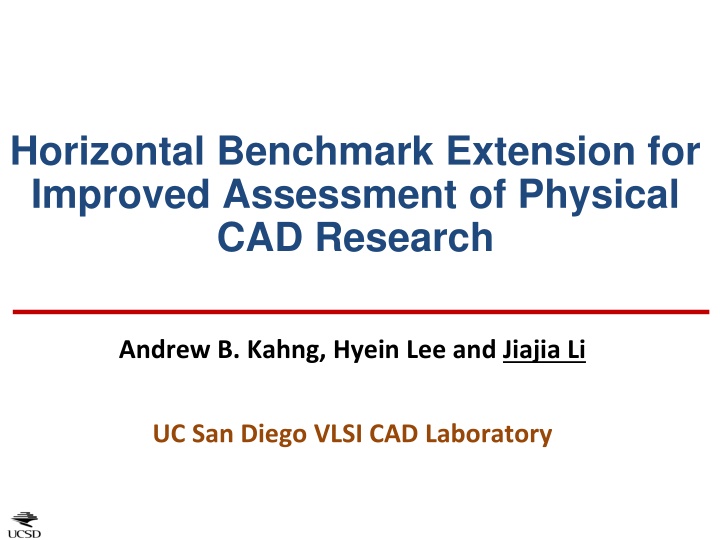
Maximizing Assessment Efficiency in Physical CAD Research
Explore the innovative approach of horizontal benchmark extension for improved assessment in physical CAD research, aiming to bridge gaps between real designs and benchmarks for optimal evaluation. Discover how UC San Diego's VLSI CAD Laboratory is revolutionizing CAD research through maximal horizontal assessment, revealing tools' suboptimality and guiding improvements.
Download Presentation

Please find below an Image/Link to download the presentation.
The content on the website is provided AS IS for your information and personal use only. It may not be sold, licensed, or shared on other websites without obtaining consent from the author. If you encounter any issues during the download, it is possible that the publisher has removed the file from their server.
You are allowed to download the files provided on this website for personal or commercial use, subject to the condition that they are used lawfully. All files are the property of their respective owners.
The content on the website is provided AS IS for your information and personal use only. It may not be sold, licensed, or shared on other websites without obtaining consent from the author.
E N D
Presentation Transcript
Horizontal Benchmark Extension for Improved Assessment of Physical CAD Research Andrew B. Kahng, Hyein Lee and Jiajia Li UC San Diego VLSI CAD Laboratory
Outline Motivation Related Work Our Methodology Experimental Setup and Results Conclusion UCSD VLSI CAD Laboratory 2
Outline Motivation Related Work Our Methodology Experimental Setup and Results Conclusion UCSD VLSI CAD Laboratory 3
Quandary in VLSI CAD Benchmarks Leading-edge , real benchmarks cannot be easily realized due to their high-value IP Old , artificial benchmarks potentially drive CAD research in stale or wrong directions How to maximally leverage available benchmarks as enablers of CAD research? 1000x gap of gate count between real designs and benchmarks Year UCSD VLSI CAD Laboratory 4
Lack of Horizontal Assessment Horizontal assessment = evaluation at one flow stage, across technologies, tools, benchmarks Maximal horizontal assessment reveals tools suboptimality guide improvements Motivation No previous work pursues maximal horizontal assessment Horizontal assessments are blocked by gaps between data models, benchmark formats, etc. UCSD VLSI CAD Laboratory 5
Scope of This Work Horizontal benchmarks and benchmark extension maximize apples-to-apples assessment UCSD VLSI CAD Laboratory 6
Outline Motivation Related Work Our Methodology Experimental Setup and Results Conclusion UCSD VLSI CAD Laboratory 7
Related Work Benchmarks based on real designs MCNC: widely used in various CAD applications ISPD98:netlist partitioning; functionality, timing and technology information are removed ISPD05/06: mixed size placement, > 2M placeable modules ISPD11: routability-driven placement, derived from industrial ASIC designs ISPD12/13: gate sizing and Vt-swapping optimization Artificial benchmarks Early works: circ/gen, gnl PEKO/PEKU: placement, w/ know-optimal solution and known upper bounds on wirelegnth Eyechart: gate sizing optimization, w/ known-optimal solution UCSD VLSI CAD Laboratory 8
Vertical vs. Horizontal Vertical benchmark [Inacio99] Multiple levels of abstraction Evaluation across a span of several flow stages Horizontal benchmark Focus on one flow stage Maximize the assessment across technologies/benchmarks/tools UCSD VLSI CAD Laboratory 9
Outline Motivation Related Work Our Methodology Experimental Setup and Results Conclusion UCSD VLSI CAD Laboratory 10
Challenges Benchmark-related challenge Limited information of benchmarks due to IP protection Limited scope of target problems Library-related challenge Unrealistic and complex constraints or design rules Hard to make fair comparisons across technologies due to different granularity (e.g., available sizes/Vt options) Different tools require different formats E.g., bookshelf format vs. LEF/DEF UCSD VLSI CAD Laboratory 11
Formats and Libraries CAD Tools require different input formats Bookshelf formats (academic) vs. DEF/LEF (commercial) Our approach: Use a converter and scripts Different libraries across technologies Missing technology files or libraries (e.g., missing LEF in ISPD12/13) Our approach: artificial LEF generation Extract cell/pin area of X1 cell from reference technology Scale cell/pin area for larger cells Granularity of libraries differ across technologies Our approach: Match granularity with timing/power table interpolations Granularity matching Liberty (timing/ power) Liberty (timing/ power) LEF generation Technology file Technology file UCSD VLSI CAD Laboratory 12
Enablement of P&R Assessments Benchmark transformation: Sizing to P&R No geometry information No physical library (LEF) Our approach: P&R with generated libraries (LEF) Generate a fake LEF if needed Run P&R with generated LEF Netlist w/ parasitics Netlist w/ parasitics P&R Geometry information Geometry information Sizing-oriented benchmark P&R-oriented benchmark Assessment across academic and commercial tools Academic tools cannot understand complex constraints / design rules (e.g., reliability constraints) Our approach: Use simple version of technology files UCSD VLSI CAD Laboratory 13
Enablement of Sizing Assessments Benchmark transformation: P&R to sizing Missing logic function / timing information (e.g., ISPD11) Our approach: Gate mapping Determine sequential cells from width / pin count / #blocks w/ same width Randomly map standard cells based on widths and pin counts Some academic sizers require complete timing graph Our approach: Attach floating nets to ports Generate additional ports if necessary based on Rent s rule Netlist w/ parasitics Netlist w/ parasitics Gate mapping Geometry information Geometry information Sizing-oriented benchmark P&R-oriented benchmark Assessment across technologies Granularities of libraries differ across technologies Our approach: Match granularity with timing/power table interpolations UCSD VLSI CAD Laboratory 14
Outline Motivation Related Work Our Methodology Experimental Setup and Results Conclusion UCSD VLSI CAD Laboratory 15
Experimental Setup Benchmarks Name netcard b19 superblue12 jpeg_encoder leo3mp Benchmark suite ISPD13 ISPD12 ISPD11 Real design Real design Gate count (P&R) 982258 219268 1286948 83241 473986 Gate count (sizing) 982258 219268 895309 83241 473986 Technologies ISPD, foundry (28/45/65/90nm) Tools Flow stage Academic tools Commercial tools Placement NTUPlace3, mPL6, FastPlace3.1 cPlacer1, cPlacer2 Global routing BFG-R cRouter1 Gate sizing UFRGS, Trident cSizer1, cSizer2 UCSD VLSI CAD Laboratory 16
Placer Assessment (Across Benchmarks) Academic placer achieves smaller HPWL except on netcard At foundry 28nm, academic placer has larger runtime, especially on large testcases (e.g., superblue12) Technology: foundry 28nm UCSD VLSI CAD Laboratory 17
Placer Assessment (Across Technologies) Academic placer achieves smaller HPWL except at 28nm Comparison results are consistent across technologies Smaller runtime of commercial placer at advanced technologies Benchmark: netcard UCSD VLSI CAD Laboratory 18
Placer Assessment (Across Tools) Results are fairly consistent among commercial tools, but vary widely across academic tools Maximal horizontal assessment can easily reveal tools suboptimality Technology: ISPD Benchmark: superblue12 UCSD VLSI CAD Laboratory 19
Combined Placer/Router Assessment Global routing solutions are roughly consistent with placement solutions Contest-induced focus on overflow reduction for BFG-R De-emphasis of wirelength metric Example of horizontal benchmark enablement: Gate sizing benchmark is mapped to foundry 28nm, placed and global routed with both academic & commercial tools larger wirelength Technology: foundry 28nm Benchmark: netcard UCSD VLSI CAD Laboratory 20
Sizer Assessment (Across Benchmarks) Academic sizer achieves similar solution quality but larger runtime (especially on large testcases) as compared to commercial sizer The assessed version of UFRGS only understands simple RC network timing violation on large designs Technology: foundry 28nm UCSD VLSI CAD Laboratory 21
Sizer Assessment (Across Technologies) Academic sizer achieves better solution quality and smaller runtime at ISPD technology, but worse solution and larger runtime at others Possibility that academic sizer is specialized to the ISPD technology Benchmark: netcard UCSD VLSI CAD Laboratory 22
Sizer Assessment (Across Tools) Academic sizers achieve smaller leakage, but have larger timing violation (due to inability to handle RC) and larger runtime Indicate potential improvements for academic sizers Technology: ISPD Benchmark: netcard UCSD VLSI CAD Laboratory 23
Outline Motivation Related Work Our Methodology Experimental Setup and Results Conclusion UCSD VLSI CAD Laboratory 24
Conclusion Horizontal benchmark extension maximally leverage available benchmark across multiple optimization domains Enable assessments of academic research within industrial tool/flow contexts, across multiple technologies and types of benchmarks Show potential improvements for academic tools Possible start of culture change , similar to Bookshelf impact? Future works Further horizontal benchmark constructions Explore gaps between academic optimizers and real-world design contexts Website: http://vlsicad.ucsd.edu/A2A/ UCSD VLSI CAD Laboratory 25
Acknowledgments We are grateful to authors of academic tools for providing binaries of their optimizers for our study UCSD VLSI CAD Laboratory 26
THANK YOU! UCSD VLSI CAD Laboratory 27


